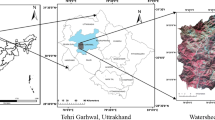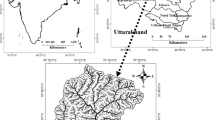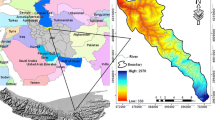Abstract
Soil is one of the most important natural resources; therefore, there is an urgent need to estimate soil erosion. The subtropical monsoon-dominated region also faces a comparatively greater problem due to heavy rainfall with high intensity in a very short time and the presence of longer dry seasons and shorter wet seasons. The Arkosa watershed faces the problem of extreme land degradation in the form of soil erosion; therefore, the rate of soil erosion needs to be estimated according to appropriate models. GCM (general circulation model) data such as MIROC5 (Model for Interdisciplinary Climate Research) of CMIP5 (Coupled Model Intercomparison Project Phase 5) have been used to project future storm rainfall and soil erosion rates following the revised universal soil loss equation (RUSLE) in various influential time frames. Apart from that, different satellite data and relevant primary field-based data for future prediction were considered. The average annual soil erosion of Arkosa watershed ranges from < 1 to > 6 t/ha/year. The very high (> 6 t/ha/year) and high (5–6 t/ha/year) soil loss areas are found in the southern, south-eastern, and eastern part of the watershed. Apart from this, low (1–2 t/ha/year) and very low (< 1 t/ha/year) soil loss areas are associated with the western, northern, southern, and major portion of the watershed. Extreme precipitation rates with high kinetic energy due to climate change are favorable to soil erosion susceptibility. The results of this research will help to implement management strategies to minimize soil erosion by keeping authorities and researchers at risk for future erosion and vulnerability.












Similar content being viewed by others
References
Abu Hammad A (2011) Watershed erosion risk assessment and management utilizing revised universal soil loss equation-geographic information systems in the Mediterranean environments: watershed erosion risk assessment in the Mediterranean environments. Water and Environment Journal 25:149–162. https://doi.org/10.1111/j.1747-6593.2009.00202.x
Arabameri A, Tiefenbacher JP, Blaschke T, Pradhan B, Tien Bui D (2020) Morphometric analysis for soil erosion susceptibility mapping using novel GIS-based ensemble model. Remote Sensing 12:874. https://doi.org/10.3390/rs12050874
Arnoldus H (1980) An approximation of the rainfall factor in the universal soil loss equation. An approximation of the rainfall factor in the universal soil loss equation 127–132
Bera A (2017) Assessment of soil loss by universal soil loss equation (USLE) model using GIS techniques: a case study of Gumti River Basin, Tripura, India. Model Earth Syst Environ 3:29. https://doi.org/10.1007/s40808-017-0289-9
Biswas SS, Pani P (2015) Estimation of soil erosion using RUSLE and GIS techniques: a case study of Barakar River basin, Jharkhand, India. Model Earth Syst Environ 1:42. https://doi.org/10.1007/s40808-015-0040-3
Blaikie P (2016) The political economy of soil erosion in developing countries, 0 edn. Routledge
Carley M, Christie I (2017) Managing sustainable development, 2nd edn. Routledge
Chakrabortty R, Ghosh S, Pal SC et al (2018) Morphometric analysis for hydrological assessment using remote sensing and GIS technique: a case study of Dwarkeswar River Basin of Bankura District, West Bengal. Asia Jour Rese Soci Scie and Human 8:113. https://doi.org/10.5958/2249-7315.2018.00074.6
Chakrabortty R, Pal SC, Sahana M, Mondal A, Dou J, Pham BT, Yunus AP (2020) Soil erosion potential hotspot zone identification using machine learning and statistical approaches in eastern India. Nat Hazards. https://doi.org/10.1007/s11069-020-04213-3
De Baets S, Poesen J, Gyssels G, Knapen A (2006) Effects of grass roots on the erodibility of topsoils during concentrated flow. Geomorphology 76:54–67. https://doi.org/10.1016/j.geomorph.2005.10.002
Edwards W, Owens L (1991) Large storm effects on total soil erosion. Journal of Soil and water Conservation 46:75–78
Ganasri BP, Ramesh H (2016) Assessment of soil erosion by RUSLE model using remote sensing and GIS-a case study of Nethravathi Basin. Geoscience Frontiers 7:953–961. https://doi.org/10.1016/j.gsf.2015.10.007
Gebrernichael D, Nyssen J, Poesen J, Deckers J, Haile M, Govers G, Moeyersons J (2005) Effectiveness of stone bunds in controlling soil erosion on cropland in the Tigray Highlands, northern Ethiopia. Soil Use & Management 21:287–297. https://doi.org/10.1111/j.1475-2743.2005.tb00401.x
Gomez J, Sobrinho T, Giraldez J, Fereres E (2009) Soil management effects on runoff, erosion and soil properties in an olive grove of southern Spain. Soil and Tillage Research 102:5–13. https://doi.org/10.1016/j.still.2008.05.005
Gupta S, Kumar S (2017) Simulating climate change impact on soil erosion using RUSLE model−a case study in a watershed of mid-Himalayan landscape. J Earth Syst Sci 126:43. https://doi.org/10.1007/s12040-017-0823-1
Hembram TK, Saha S (2020) Prioritization of sub-watersheds for soil erosion based on morphometric attributes using fuzzy AHP and compound factor in Jainti River basin, Jharkhand, eastern India. Environ Dev Sustain 22:1241–1268. https://doi.org/10.1007/s10668-018-0247-3
Karaburun A (2010) Estimation of C factor for soil erosion modeling using NDVI in Buyukcekmece watershed. Ozean journal of applied sciences 3:77–85
Keesstra S, Mol G, de Leeuw J, Okx J, Molenaar C, de Cleen M, Visser S (2018) Soil-related sustainable development goals: four concepts to make land degradation neutrality and restoration work. Land 7:133. https://doi.org/10.3390/land7040133
Kouli M, Soupios P, Vallianatos F (2009) Soil erosion prediction using the revised universal soil loss equation (RUSLE) in a GIS framework, Chania, Northwestern Crete, Greece. Environ Geol 57:483–497. https://doi.org/10.1007/s00254-008-1318-9
Kumar S (2019) Geospatial approach in modeling soil erosion processes in predicting soil erosion and nutrient loss in hilly and mountainous landscape. In: Navalgund RR, Kumar AS, Nandy S (eds) Remote sensing of northwest Himalayan ecosystems. Springer Singapore, Singapore, pp 355–380
Lal R (2001) Soil degradation by erosion. Land Degrad Dev 12:519–539. https://doi.org/10.1002/ldr.472
Lal R (2005) Soil erosion and carbon dynamics. Soil and Tillage Research 81:137–142. https://doi.org/10.1016/j.still.2004.09.002
Lal R (2017) Soil erosion by wind and water: problems and prospects. In: Soil Erosion Research Methods, 2nd edn. Routledge, pp 1–10
Lane LJ, Hernandez M, Nichols M (1997) Processes controlling sediment yield from watersheds as functions of spatial scale. Environmental Modelling & Software 12:355–369. https://doi.org/10.1016/S1364-8152(97)00027-3
Malik S, Pal SC, Das B, Chakrabortty R (2019) Intra-annual variations of vegetation status in a sub-tropical deciduous forest-dominated area using geospatial approach: a case study of Sali watershed, Bankura, West Bengal, India. Geology, Ecology, and Landscapes 1–12
Malik S, Pal SC, Sattar A, Singh SK, Das B, Chakrabortty R, Mohammad P (2020) Trend of extreme rainfall events using suitable global circulation model to combat the water logging condition in Kolkata Metropolitan Area. Urban Climate 32:100599. https://doi.org/10.1016/j.uclim.2020.100599
Mishra BK, Rafiei Emam A, Masago Y, Kumar P, Regmi RK, Fukushi K (2018) Assessment of future flood inundations under climate and land use change scenarios in the Ciliwung River Basin, Jakarta. Journal of Flood Risk Management. 11:S1105–S1115. https://doi.org/10.1111/jfr3.12311
Moore ID, Burch GJ (1986) Physical basis of the length-slope factor in the universal soil loss equation. Soil Science Society of America Journal 50:1294–1298. https://doi.org/10.2136/sssaj1986.03615995005000050042x
Morgan R, Quinton J, Smith R et al (1998) The European soil erosion model (EUROSEM): a dynamic approach for predicting sediment transport from fields and small catchments. Earth Surface Processes and Landforms: The Journal of the British Geomorphological Group 23:527–544
Neave M, Rayburg S (2007) A field investigation into the effects of progressive rainfall-induced soil seal and crust development on runoff and erosion rates: the impact of surface cover. Geomorphology 87:378–390. https://doi.org/10.1016/j.geomorph.2006.10.007
Nyaupane N, Mote SR, Bhandari M, et al (2018) Rainfall-runoff simulation using climate change based precipitation prediction in HEC-HMS Model for Irwin Creek, Charlotte, North Carolina. In: World Environmental and Water Resources Congress 2018: Watershed Management, Irrigation and Drainage, and Water Resources Planning and Management - Selected Papers from the World Environmental and Water Resources Congress 2018
Oldeman LR, Hakkeling R, Sombroek WG (1990) World map of the status of human-induced soil degradation: an explanatory note. International Soil Reference and Information Centre
Pal S (2016) Identification of soil erosion vulnerable areas in Chandrabhaga river basin: a multi-criteria decision approach. Model Earth Syst Environ 2:5. https://doi.org/10.1007/s40808-015-0052-z
Pal SC, Chakrabortty R (2019a) Modeling of water induced surface soil erosion and the potential risk zone prediction in a sub-tropical watershed of eastern India. Modeling Earth Systems and Environment 5:369–393
Pal SC, Chakrabortty R (2019b) Simulating the impact of climate change on soil erosion in sub-tropical monsoon dominated watershed based on RUSLE, SCS runoff and MIROC5 climatic model. Advances in Space Research 64:352–377
Pal SC, Shit M (2017) Application of RUSLE model for soil loss estimation of Jaipanda watershed, West Bengal. Spatial Information Research 25:399–409
Pal SC, Chakrabortty R, Malik S, Das B (2018) Application of forest canopy density model for forest cover mapping using LISS-IV satellite data: a case study of Sali watershed, West Bengal. Model Earth Syst Environ 4:853–865. https://doi.org/10.1007/s40808-018-0445-x
Panagos P, Karydas CG, Gitas IZ, Montanarella L (2012) Monthly soil erosion monitoring based on remotely sensed biophysical parameters: a case study in Strymonas river basin towards a functional pan-European service. International Journal of Digital Earth 5:461–487. https://doi.org/10.1080/17538947.2011.587897
Panagos P, Borrelli P, Meusburger K (2015) A new European slope length and steepness factor (LS-factor) for modeling soil erosion by water. Geosciences 5:117–126. https://doi.org/10.3390/geosciences5020117
Pimentel D (2006) Soil erosion: a food and environmental threat. Environ Dev Sustain 8:119–137. https://doi.org/10.1007/s10668-005-1262-8
Plangoen P, Babel M, Clemente R, Shrestha S, Tripathi N (2013) Simulating the impact of future land use and climate change on soil erosion and deposition in the Mae Nam Nan sub-catchment, Thailand. Sustainability 5:3244–3274. https://doi.org/10.3390/su5083244
Prasannakumar V, Vijith H, Abinod S, Geetha N (2012) Estimation of soil erosion risk within a small mountainous sub-watershed in Kerala, India, using revised universal soil loss equation (RUSLE) and geo-information technology. Geoscience Frontiers 3:209–215. https://doi.org/10.1016/j.gsf.2011.11.003
Renard KG, USA, USA (eds) (1997) Predicting soil erosion by water: a guide to conservation planning with the revised universal soil loss equation (RUSLE), Washington, D. C
Rouse Jr J (1974) Monitoring the vernal advancement and retrogradation (green wave effect) of natural vegetation
Roy P, Chakrabortty R, Chowdhuri I, Malik S, Das B, Pal SC (2020a) Development of different machine learning ensemble classifier for gully erosion susceptibility in Gandheswari Watershed of West Bengal, India. In: Rout JK, Rout M, Das H (eds) Machine Learning for Intelligent Decision Science. Springer Singapore, Singapore, pp 1–26
Roy P, Pal SC, Chakrabortty R et al (2020b) Threats of climate and land use change on future flood susceptibility. Journal of Cleaner Production 122757
Saha A, Ghosh M, Pal SC (2020) Gully Erosion Studies from India and Surrounding Regions. In: Understanding the morphology and development of a rill-gully: an empirical study of Khoai Badland, West Bengal, India. Springer, In, pp 147–161
Senanayake S, Pradhan B, Huete A, Brennan J (2020) Assessing soil erosion hazards using land-use change and landslide frequency ratio method: a case study of Sabaragamuwa Province, Sri Lanka. Remote Sensing 12:1483
Shit P, Bhunia G, Maiti R (2015) Farmers’ perceptions of soil erosion and management strategies in South Bengal in India. European Journal of Geography 6:85–100
Shrestha S, Lohpaisankrit W (2017) Flood hazard assessment under climate change scenarios in the Yang River Basin, Thailand. International Journal of Sustainable Built Environment. 6:285–298. https://doi.org/10.1016/j.ijsbe.2016.09.006
Stoorvogel JJ, Bakkenes M, Temme AJAM, Batjes NH, Brink BJE (2017) S-world: a global soil map for environmental modelling. Land Degrad Develop 28:22–33. https://doi.org/10.1002/ldr.2656
Teng H, Liang Z, Chen S, Liu Y, Viscarra Rossel RA, Chappell A, Yu W, Shi Z (2018) Current and future assessments of soil erosion by water on the Tibetan Plateau based on RUSLE and CMIP5 climate models. Science of The Total Environment 635:673–686. https://doi.org/10.1016/j.scitotenv.2018.04.146
Thomas J, Joseph S, Thrivikramji KP (2018) Assessment of soil erosion in a tropical mountain river basin of the southern Western Ghats, India using RUSLE and GIS. Geoscience Frontiers 9:893–906. https://doi.org/10.1016/j.gsf.2017.05.011
Tiwari H, Rai SP, Kumar D, Sharma N (2016) Rainfall erosivity factor for India using modified Fourier index. Journal of Applied Water Engineering and Research 4:83–91. https://doi.org/10.1080/23249676.2015.1064038
Toubal AK, Achite M, Ouillon S, Dehni A (2018) Soil erodibility mapping using the RUSLE model to prioritize erosion control in the Wadi Sahouat basin, north-west of Algeria. Environ Monit Assess 190:210. https://doi.org/10.1007/s10661-018-6580-z
Van der Knijff J, Jones R, Montanarella L (2000) Soil erosion risk assessment in Europe, EUR 19044 EN. Office for official publications of the European communities, Luxembourg 34
Van Remortel RD, Maichle RW, Hickey RJ (2004) Computing the LS factor for the revised universal soil loss equation through array-based slope processing of digital elevation data using a C++ executable. Computers & geosciences 30:1043–1053
Van Romortel R, Hamilton M, Hickey R (2001) Estimating the LS factor for RUSLE through iterative slope length processing of digital elevation data within ArcInfo grid. Cartography 30:27–35
Wang X, Li Z, Cai C, Shi Z, Xu Q, Fu Z, Guo Z (2012) Effects of rock fragment cover on hydrological response and soil loss from Regosols in a semi-humid environment in South-West China. Geomorphology 151–152:234–242. https://doi.org/10.1016/j.geomorph.2012.02.008
Wischmeier WH (1978) Predicting rainfall erosion losses. USDA agricultural research services handbook 537
Wischmeier WH, Smith DD (1958) Rainfall energy and its relationship to soil loss. Trans AGU 39:285. https://doi.org/10.1029/TR039i002p00285
Wischmeier WH, Johnson C, Cross V (1971) A soil erodibility nomograph forfarmland and construction sites. Journal of Soil and Water Conservation 26(5):189–193
Yang D, Kanae S, Oki T, Koike T, Musiake K (2003) Global potential soil erosion with reference to land use and climate changes. Hydrol Process 17:2913–2928. https://doi.org/10.1002/hyp.1441
Zeng C, Wang S, Bai X, Li Y, Tian Y, Li Y, Wu L, Luo G (2017) Soil erosion evolution and spatial correlation analysis in a typical karst geomorphology using RUSLE with GIS. Solid Earth 8:721–736. https://doi.org/10.5194/se-8-721-2017
Zhang XC, Nearing MA (2005) Impact of climate change on soil erosion, runoff, and wheat productivity in central Oklahoma. Catena 61:185–195
Zhou P, Luukkanen O, Tokola T, Nieminen J (2008) Effect of vegetation cover on soil erosion in a mountainous watershed. CATENA 75:319–325. https://doi.org/10.1016/j.catena.2008.07.010
Funding
The authors are thankful to the NRDMS, DST, for their financial assistance (NRDMS/01/143/016) to carry out this research work.
Author information
Authors and Affiliations
Contributions
No other author is associated with collecting the data, designing the methods, and writing the manuscript.
Corresponding author
Ethics declarations
Competing interests
The authors declare that they have no competing interests.
Additional information
Responsible Editor: Stefan Grab
Rights and permissions
About this article
Cite this article
Chakrabortty, R., Pradhan, B., Mondal, P. et al. The use of RUSLE and GCMs to predict potential soil erosion associated with climate change in a monsoon-dominated region of eastern India. Arab J Geosci 13, 1073 (2020). https://doi.org/10.1007/s12517-020-06033-y
Received:
Accepted:
Published:
DOI: https://doi.org/10.1007/s12517-020-06033-y




